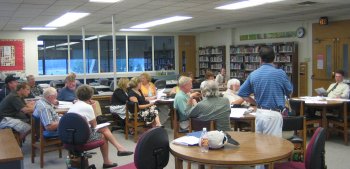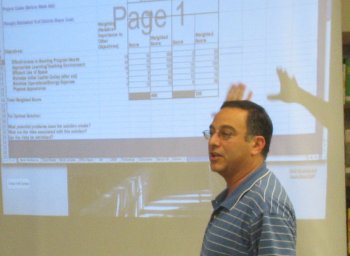- By Dan Veaner
- News
 Print
Print
The Lansing Schools Facilities Committee came to an impasse Wednesday when two factions spent the entire meeting arguing about the process. The agenda called for the group to choose alternative solutions to problems that affect programs in the High School, including insufficient space for music, science, computer lab, and classrooms. But the group was unable to get past procedural issues, with the two and a half hour argument getting heated and personal at times.

The one thing the committee did accomplish was to take Middle School capital improvements off the table. While required repairs to infrastructure will be addressed, items such as reconfiguring art, music and science rooms will not be part of the project. This puts the focus onto the High School where overcrowding and unsafe conditions are supposed to be addressed by the capital project.
The committee was formed last March to build a capital project 'from the ground up' after the Board Of Education (BOE) failed to bring an earlier version to the voters, fearing the $40 million (give or take) project would be defeated. A call for residents from all segments of the school district attracted approximately 30 residents, teachers, and administrators to participate on the Facilities Group. Another half dozen or so joined the Community Awareness Group, the purpose of which is to funnel information between the community at large and the Facilities Group. The idea was that if the project was developed by community members that district voters were more likely to support it.
With that in mind community member Mark Stammer was tapped to facilitate the process, rather than putting a school official in that role. Stammer has led, or tried to lead a situational analysis process that starts by identifying what is important to the community, sets priorities, and eventually focuses on identifying alternative solutions to problems the group identifies. Once that is done the process is to choose the solution the group thinks best solves the problem given the community's overall priorities. Finally the group will take the list of solutions and perform a kind of triage, deciding which fit within an acceptable cost for the entire project. The group's recommendations, including dissenting views, will be presented to the BOE, which will then craft the final project.
Wednesday was to be the second of two sessions in which the group chose the best solutions to specific problems. Despite the fact that the committee followed the same procedure with the same format of worksheet in their last meeting, some members questioned everything from administrators' ranking of items to the solutions themselves, which had previously been developed by the committee. David Dittman accused Principal Michelle Stone of giving the same weight to everything on the list. But Bobbi Wasenko said, "I'm very capable of looking at this information and prioritizing it myself. Michelle has stated her case and I think she has done an eloquent job."
Dittman replied, "Michelle stated her case verbally. I don't remember it." At that point Curriculum Director Deb Pichette noted that the Community Awareness Group had published a summary of the issues and read her copy to the group. That didn't satisfy Dittman, who has complained throughout the process that the committee is making decisions without the information it needs to make them informed decisions. Stone said that she doesn't give every item the same weight, giving examples of issues she thought more important than others.
Most of the meetings have begun with procedural arguments that last an average of an hour. But the group has then managed to go through the procedure and accomplish something. "Time out!" said Stammer at the mid-point of the meeting. "Let's not get so emotional. This is supposed to be a rational process."

Mark Stammer explains a decision matrix page
Some members have said they feel Stammer has not adequately explained the process beforehand so that members are confused about what is expected of them in any given session. Even after it was explained that rankings were meant as guides that the committee could adjust, endless discussion of rankings prevented the group from addressing the alternative solutions.
Dittman complained that the only solutions were to build or do nothing. He maintained that there are also programmatic solutions to some of the issues, such as Dan Konowolo's suggestion to lengthen the school day to relieve over scheduling of classrooms. He also suggested allowing five minutes instead of three between class sessions to allow students to put backpacks in their lockers, instead of littering the hallways with them when there is no space in the classroom. But Superintendent Mark Lewis noted that there are contractual obstacles to lengthening the school day, and that it would cost the district more to pay teachers for a longer work day if the union were to accept it.
Lewis repeatedly reminded the group that it is not within its scope to set policy on school programs. But Konowalo and others maintained that limited the committee's options. Cuts in music and arts programs were suggested. Stone lamented that was probably going to have to happen, saying, "I'm going to get to a point, especially with band, where I'll have to do something programmatically. I can't hold on too much longer hoping for something to change."
When 9 o'clock came the meeting simply broke up. No action was taken on the items, and the group decided to pick up where they left off at their next meeting on August 2.
----
v2i29

The one thing the committee did accomplish was to take Middle School capital improvements off the table. While required repairs to infrastructure will be addressed, items such as reconfiguring art, music and science rooms will not be part of the project. This puts the focus onto the High School where overcrowding and unsafe conditions are supposed to be addressed by the capital project.
The committee was formed last March to build a capital project 'from the ground up' after the Board Of Education (BOE) failed to bring an earlier version to the voters, fearing the $40 million (give or take) project would be defeated. A call for residents from all segments of the school district attracted approximately 30 residents, teachers, and administrators to participate on the Facilities Group. Another half dozen or so joined the Community Awareness Group, the purpose of which is to funnel information between the community at large and the Facilities Group. The idea was that if the project was developed by community members that district voters were more likely to support it.
With that in mind community member Mark Stammer was tapped to facilitate the process, rather than putting a school official in that role. Stammer has led, or tried to lead a situational analysis process that starts by identifying what is important to the community, sets priorities, and eventually focuses on identifying alternative solutions to problems the group identifies. Once that is done the process is to choose the solution the group thinks best solves the problem given the community's overall priorities. Finally the group will take the list of solutions and perform a kind of triage, deciding which fit within an acceptable cost for the entire project. The group's recommendations, including dissenting views, will be presented to the BOE, which will then craft the final project.
Wednesday was to be the second of two sessions in which the group chose the best solutions to specific problems. Despite the fact that the committee followed the same procedure with the same format of worksheet in their last meeting, some members questioned everything from administrators' ranking of items to the solutions themselves, which had previously been developed by the committee. David Dittman accused Principal Michelle Stone of giving the same weight to everything on the list. But Bobbi Wasenko said, "I'm very capable of looking at this information and prioritizing it myself. Michelle has stated her case and I think she has done an eloquent job."
Dittman replied, "Michelle stated her case verbally. I don't remember it." At that point Curriculum Director Deb Pichette noted that the Community Awareness Group had published a summary of the issues and read her copy to the group. That didn't satisfy Dittman, who has complained throughout the process that the committee is making decisions without the information it needs to make them informed decisions. Stone said that she doesn't give every item the same weight, giving examples of issues she thought more important than others.
Most of the meetings have begun with procedural arguments that last an average of an hour. But the group has then managed to go through the procedure and accomplish something. "Time out!" said Stammer at the mid-point of the meeting. "Let's not get so emotional. This is supposed to be a rational process."

Mark Stammer explains a decision matrix page
Some members have said they feel Stammer has not adequately explained the process beforehand so that members are confused about what is expected of them in any given session. Even after it was explained that rankings were meant as guides that the committee could adjust, endless discussion of rankings prevented the group from addressing the alternative solutions.
Dittman complained that the only solutions were to build or do nothing. He maintained that there are also programmatic solutions to some of the issues, such as Dan Konowolo's suggestion to lengthen the school day to relieve over scheduling of classrooms. He also suggested allowing five minutes instead of three between class sessions to allow students to put backpacks in their lockers, instead of littering the hallways with them when there is no space in the classroom. But Superintendent Mark Lewis noted that there are contractual obstacles to lengthening the school day, and that it would cost the district more to pay teachers for a longer work day if the union were to accept it.
Lewis repeatedly reminded the group that it is not within its scope to set policy on school programs. But Konowalo and others maintained that limited the committee's options. Cuts in music and arts programs were suggested. Stone lamented that was probably going to have to happen, saying, "I'm going to get to a point, especially with band, where I'll have to do something programmatically. I can't hold on too much longer hoping for something to change."
When 9 o'clock came the meeting simply broke up. No action was taken on the items, and the group decided to pick up where they left off at their next meeting on August 2.
----
v2i29



